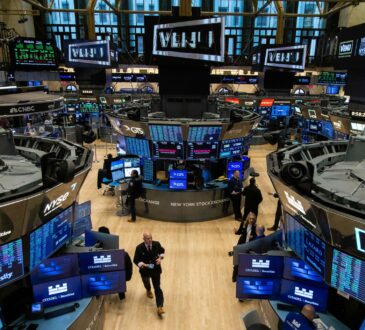
NEW YORK (AP) — U.S. stock indexes are rallying toward records Friday as they close out their latest winning week following some mixed signals on big banks’ profits and on inflation.
The S&P 500 was up 1.2% in afternoon trading and on track to top its all-time high set on Wednesday. The Dow Jones Industrial Average was up 449 points, or 1.1%, as of 2:06 p.m. Eastern time, and the Nasdaq composite was 1.4% higher. The Dow and Nasdaq are also are on on track for record highs.
Bank of New York Mellon climbed 5.6% for one of the market’s bigger gains after it reported better profit for the spring than analysts expected. Nvidia and several other highly influential Big Tech stocks also helped lift the market after a rare slide the prior day, which interrupted their rocket ride higher amid a frenzy around artificial-intelligence technology.
They helped offset a drop for Wells Fargo, which sank 5.8% even though the San Francisco-based bank reported stronger profit than analysts expected. It said a key underlying measure of profit fell from a year ago and that its net interest income could remain in the bottom half of the range it had forecast for the full year.
In the bond market, which has been home to some of Wall Street’s strongest action this week, Treasury yields yo-yoed after the release of the latest update on inflation, which said prices rose more at the wholesale level last month than economists expected. It’s a letdown following Thursday’s report that said inflation at the consumer level last month was better than expected.
But after a couple initial swings, Treasury yields calmed and remained lower than they were late Thursday.
“It’s still going to take some time before we know whether yesterday’s number or today’s was the aberration,” said Chris Larkin, managing director of trading and investing at E-Trade from Morgan Stanley.
Some of the acceleration in Friday’s data could be the result of higher profit margins for businesses, which can swing sharply and some analysts called irrelevant to the inflation fighters at the Federal Reserve.
Also helping to keep yields anchored was a report suggesting U.S. households aren’t as fearful about inflation staying so high in the future. Over the coming year, U.S. consumers are forecasting inflation of 2.9%, according to preliminary data from the University of Michigan.
It’s the second straight month such expectations have eased, which can be a big deal to the Federal Reserve. The fear is expectations for high inflation by U.S. consumers could drive behavior that would push it even higher and create a self-fulfilling cycle.
After climbing as high as 4.23% following the wholesale inflation report’s release, the 10-year Treasury yield settled back down to 4.19% from 4.21% late Thursday.
The two-year yield, which moves more closely with expectations for Fed action, eased to 4.47% from 4.51% late Thursday.
Traders are banking on a 94% probability that inflation is slowing enough for the Federal Reserve to begin cutting its main interest rate in September, according to data from CME Group. Wall Street has been hoping for cuts to the Fed’s main interest rate, which is sitting at its highest level in more than two decades.
Lower interest rates would release pressure that’s built up on the economy because of how expensive it’s become to borrow money to buy houses, cars, or anything on credit cards. Fed officials, though, have been saying they want to see “more good data” on inflation before making a move.
Easier interest rates would help all types of businesses, and smaller companies could see big benefits because of how much they borrow to grow. The smaller stocks in the Russell 2000 pulled decisively higher above their larger counterparts in the S&P 500 index on Thursday following the encouraging data on inflation data at the consumer level, and that continued on Friday.
The Russell 2000 rallied 1.3% and is on pace for its best week since November.
Of course, traders have a long history of being premature about forecasting cuts to rates. JPMorgan Chase CEO Jamie Dimon warned Friday that inflation and interest rates may stay higher than the market expects because of the U.S. government’s spiraling debt and other factors.
In stock markets abroad, Japan’s Nikkei 225 gave back some of its recent record-breaking run and fell 2.4%, though it’s still up more than 23% for the year so far.
Indexes were mixed across the rest of Asia and higher in much of Europe.
___
AP Writers Matt Ott and Zimo Zhong contributed.


